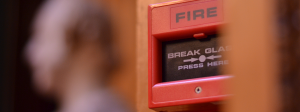Posted September 3, 2016
If you own, occupy or have control of any premises then you are responsible for fire safety. The more control you have, the more responsibility.
What is Fire Safety?
Fire Safety describes the steps you take in order to reduce the liklihood of a fire, reduce the destruction caused by fire and ensure that anyone in the building can escape from a fire safely.
Our Top Ten Tips
Here are our top ten tips for keeping your premises safe.
- Carry out a fire risk assessment regularly. Have a walk around your premises to see if you can spot any potential hazards, any blockages to escape routes and check that the area is adequately protected. When you walk round, ask yourself “Is there anything here which could cause a fire?”, “Is there anything which could fuel a fire?”, “If there was a fire here, is there adequate protection and ways of notifiying the people in the building?” and “Could people escape from the fire effectively?”
- Keep walkways and fire exits clear. In the event of a fire it is essential that people know whick way to exit and are able to use that route quickly and safely. Add signage to crucial fire exit routes to maintain safety levels, and walk round the building regularly to check for hazards. Check that the exit doors open and that automatic fire doors are kept closed.
- Train your staff. It’s a good idea to train supervisors and employees regularly to keep areas tidy and free from obstruction. Make sure that all staff know what to do in case of fire, that they understand where they must go and what they should do to prevent a fire.
- Test your system regularly. As a user you are able to perform tests on the fire safety equipment. It’s a good idea to test:
- Manual Call Points. Check to see if it sounds the alarm and that everyone can hear it. Each time you do this, test a different call point.
- Batteries. Test that the battery used in the fire alarm is ok.
- Have your fire alarm system maintained at least once every 6 months. The maintenance must be done by a “competent person” – this can be a third party accredited company or UKAS accredited body. This maintenance should include inspection of the log book and false alarm records, battery check, control panel and fire alarm components check and a comprehensive visual inspection.
- Perform regular fire drills. You must have a fire drill once per year and keep the results and records on file as part of your fire safety and evacuation plan. If you have visitors it’s a good idea to have a recording mechanism so you know exactly how many people are on site.
- Check storage areas. Storage areas can become messy quickly. It’s a good idea to check that cupboards and storage rooms are kept tidy. It’s also useful to check that goods stored are not blocking fire exits or fire alarm equipment, and that they are safely stacked to avoid collapse. If you store flammable liquid, make sure you have adequate signage, that they are kept away from ignition sources and that they are stored in safe storage.
- Smoking policy. Is it clear where smoking is allowed on your premises, do you have adequate means of extinguishing cigarettes and are the recepticles cleared regularly?
- Maintain your heating systems regularly. Equipment such as convection heaters and gas boilers should be checked to ensure that airvents are not covered, that they can not be knocked over and that they are not kept beside any combustibles.
- Maintain machinery. If your building contains machines of any sort, make sure they are maintained regularly, that they are PAT tested (where applicable), that they are kept clean and that they are located so as to prevent congestion.
We are here to help and advise on any fire or security issue. If you want to talk to us then please get in touch via our “Contact Us” page and we’d be glad to help.

